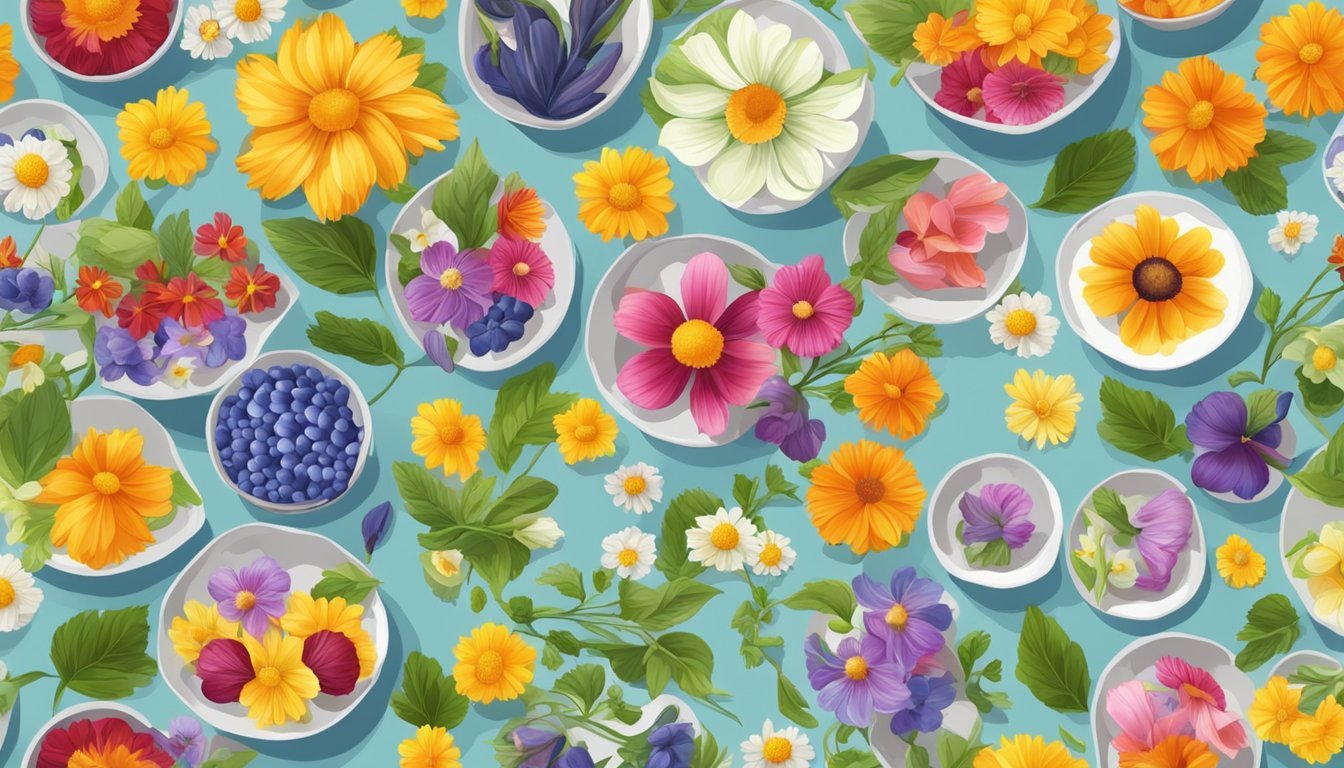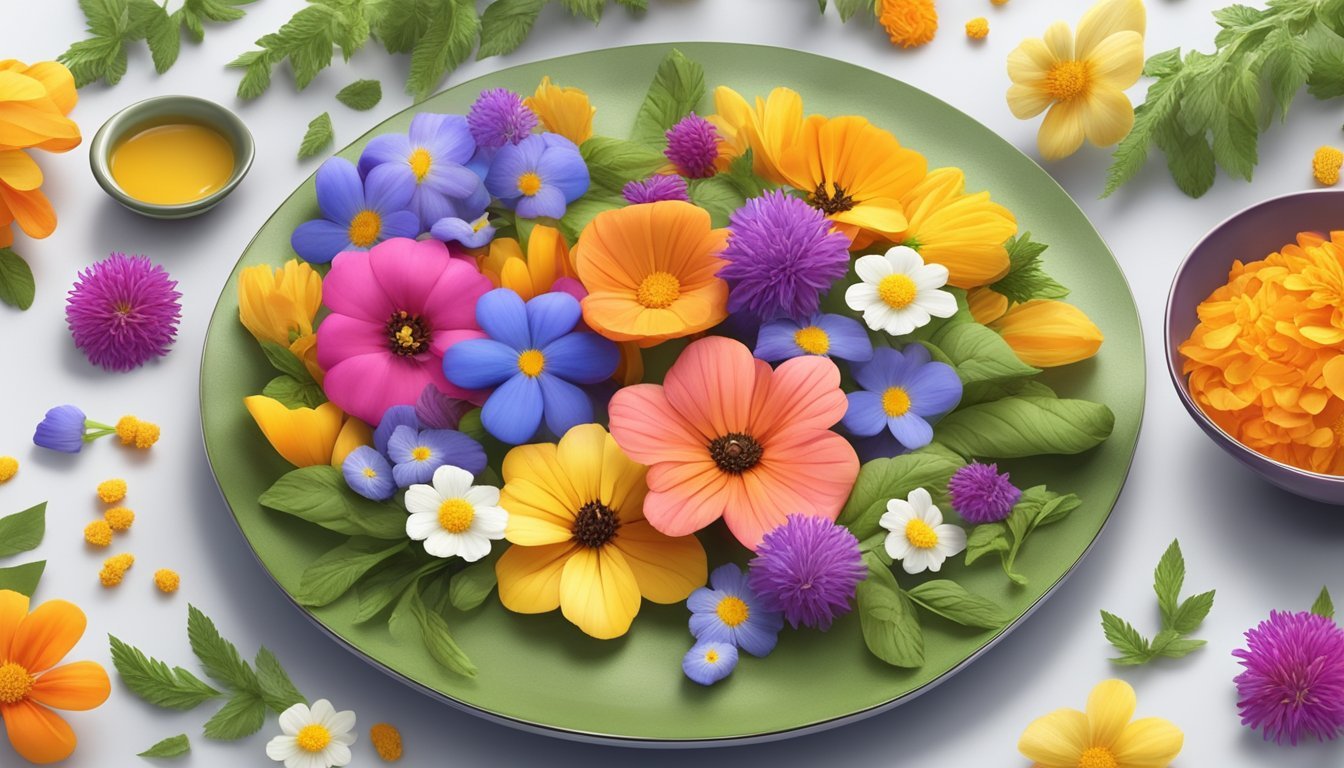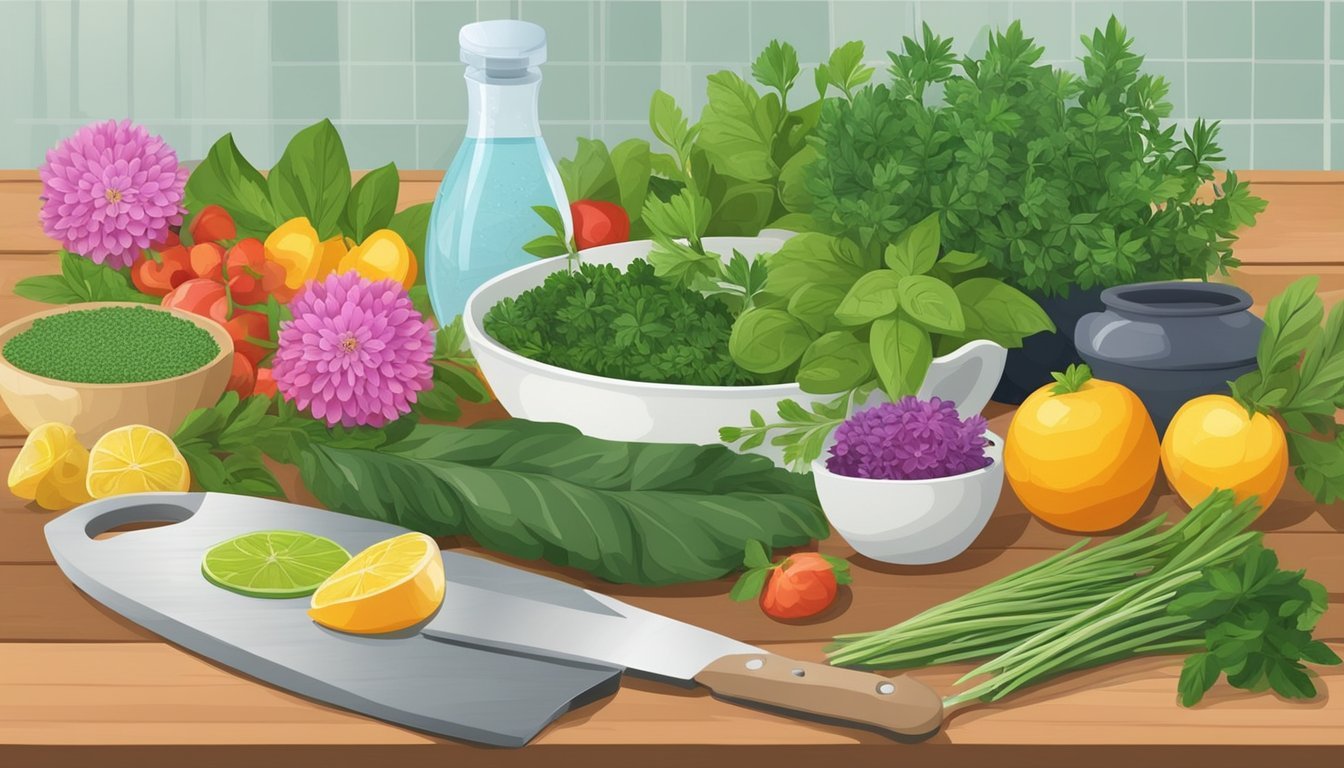How to Cook with Flowers for Edible Decorations
A Guide to Elegant Culinary Creations
Cooking with flowers is not a new concept, but it is one that has captured the culinary imagination with its blend of aesthetics and flavors. Edible flowers add a burst of color and a unique taste to dishes, turning an ordinary meal into something extraordinary. They range from subtly herbaceous to sweetly floral, and they can be used in everything from salads (What wine goes well with salads?) and soups to desserts and drinks.
These floral ingredients are not only about looks; they often come with their own distinctive flavors. For example, lavender has a sweet, perfumed essence that can be infused into sweets and baked goods, while the peppery notes of nasturtium can spice up a salad. It's important for chefs and home cooks alike to know not only which flowers are safe to eat but also how to prepare them to ensure they complement and elevate a dish.
While integrating edible flowers into cooking, one must consider both their culinary and aesthetic impact. Flowers can be crystallized for a sparkly effect, floated in beverages for a touch of elegance, or used as a fresh garnish to add color to a plate. When preparing flowers for consumption, gentle handling and proper cleaning are key to preserving their delicate structures and to ensure safety.
Choosing the Right Edible Flowers
When selecting edible flowers for culinary use, one must be discerning to ensure both the safety and aesthetic appeal of their dishes. It is imperative to choose flowers that are explicitly labeled as edible. Garden grown varieties can be an excellent source, provided they are cultivated without the use of pesticides or harmful chemicals.
List of Common Edible Flowers:
Chive Blossoms
Nasturtiums
Pansies
Marigolds
Violas
To consider when foraging or purchasing:
Garden Origination: If sourced from a garden, ensure it's a chemical-free environment.
Pesticide-Free: Always seek out organically grown flowers, free from pesticides.
Florist Warning: Flowers from conventional florists may contain high levels of pesticides and are generally not suitable for consumption.
Identification: One must correctly identify the flower species, as some have non-edible lookalikes. Utilize reputable guides or expert advice to avoid any confusion with non-edible flowers.
Edible Non-Edible Roses Hyacinth Lilacs Hydrangea
Usage Tips:
Incorporate in salads for flavor and color.
Create infused oils and vinegars.
As garnishes for drinks and dishes.
Candied flowers for desserts.
In conclusion, careful selection is crucial in using edible flowers to ensure a successful culinary experience. With the right knowledge and attention to detail, they can offer a unique touch to a variety of dishes.
Preparation of Edible Flowers
Before using flowers as edible decorations, it's essential to ensure they are suitable for consumption. Not all flowers are edible, and some can be poisonous. One must know which flowers are safe to eat and ensure they are free from pesticides and other chemicals.
Cleaning: Begin by gently washing the flowers in a bowl of water. Care should be taken to lightly shake them to remove dirt and small insects. Pat them dry with a soft cloth or a paper towel carefully to avoid bruising.
Storage: If not using immediately, store them between layers of damp paper towels inside a sealed container in the refrigerator. This helps to maintain their freshness until they're ready to be used.
Removal of Pollen: For some flowers, removing the pollen can enhance the taste and reduce potential allergens. Use a pair of tweezers or a small brush to delicately remove the pollen from the flowers.
Candying: To candy flowers, such as violets or rose petals, prepare an egg wash (one egg white beaten until frothy). With a fine paintbrush, coat the flower evenly with egg wash, sprinkle with fine sugar, then let dry on waxed paper.
Usage in Salads: Edible flowers can add a pop of color and a unique flavor to any salad. Sprinkle flowers whole or torn into petals directly onto the salad before serving.
Freezing in Ice: Small flowers can be frozen in water to create decorative ice cubes for a refreshing and beautiful touch in drinks.
Note: Always use flowers that have been identified as safe for consumption and have not been treated with chemicals that are not food-grade.
Incorporating Flowers into Sweet Dishes
Cooking with flowers introduces vibrant colors and unique flavors to sweet dishes, transforming everyday desserts into extraordinary showpieces. When incorporating petals into cakes (how long do cakes last?) or creating a floral sugar, the key is to choose edible flowers known for their sweet aroma and compatibility with dessert ingredients.
Decorating Cakes and Desserts
To use flowers in decorating cakes and desserts, one should select fresh, pesticide-free petals that are known to be edible. Candied viola petals make for a delightful and simple adornment on desserts. They can be placed on a fresh frosting, embedded into soft meringue, or gently laid on whipped cream. Petals can also add elegance to lemon curd-filled pastries or as a garnish on a baking sheet of homemade cookies.
Creating Edible Flower Sugar
To create an aromatic edible flower sugar:
Blend dry, pesticide-free petals (such as rose or lavender) with granulated sugar in a 1:2 ratio of flowers to sugar.
Store the mixture in an airtight container for a few days to allow the oils from the petals to perfume the sugar.
Use this flavored sugar to sweeten teas, sprinkle on cookies, or dust over cakes for an added floral note.
Infusing Teas with Floral Notes
For those looking to infuse teas with a hint of floral sweetness, edible flowers like Anise Hyssop can be a perfect choice. It can be steeped directly with tea leaves, introducing subtle mint and licorice flavors to the infusion. Additionally, tea blends can be enhanced with dried petals, creating visually stunning and flavorful blends that can act as a calmative and a digestive aid.
Savory Applications for Edible Flowers
Edible flowers provide a unique opportunity to enhance savory dishes with both color and flavor. Chefs and home cooks alike can integrate them into a variety of savory preparations, elevating simple plates into visually appealing and tasty culinary experiences.
Salads with a Floral Twist
Salads gain a visual pop and a subtle taste complexity with the introduction of edible flowers. One can mix fresh petals—such as those from marigolds or pansies—with greens to craft a visually stunning salad. Chive blossoms add a mild onion flavor and a burst of purple color, complementing the textures and tastes of ingredients like turnips and goat cheese.
Example Salad Blend:
Greens: Arugula, spinach, or mixed greens
Flowers: Chive blossoms, pansy petals
Extras: Sliced turnips, crumbled goat cheese
Dressing: Olive oil, honey, lime juice, seasoned with salt and pepper
Adding Flowers to Appetizers and Main Courses
Edible flowers like nasturtiums and squash blossoms can be integrated into appetizers and main courses to create highly appealing dishes both in flavor and presentation. Stuff squash blossoms with herbed goat cheese and bake or lightly fry for a delicate and savory appetizer. Flowers can also be mixed in with pasta or sprinkled over grilled fish or vegetables, delivering both a fresh aspect and an enchanting appearance.
Edible Flowers for Main Courses:
Nasturtiums: Peppery taste, great for stuffing
Squash Blossoms: Sweet and succulent, ideal for fillings
Rosemary Flowers: A mild version of the herb, perfect for garnishing meats
Garnishing Soups and Cocktails
Soups and cocktails benefit from the addition of edible flowers not only as garnish but also as a flavor enhancer. For soups, a sprinkle of vibrant calendula petals can add a slight peppery note similar to saffron. A crystallized violet or a borage flower can turn a simple cocktail into an extraordinary beverage, both in taste and in aesthetics.
Garnishing Examples:
Soups: Calendula petals for a hint of spice and color
Cocktails: Crystallized violets for a touch of elegance and sweetness
Flavor Enhancements Using Flowers
Cooking with edible flowers adds not just visual appeal to dishes but also a variety of subtle to pronounced flavors. Aesthetic garnishes such as nasturtiums and pansies can transform a simple plate into a striking presentation. These flowers, however, provide more than just color; nasturtiums impart a pleasantly peppery taste while pansies offer a mildly grassy flavor.
When it comes to infusing floral notes and adding a touch of elegance, few ingredients work as well as lavender and roses. Both can be sprinkled over desserts like fruit tarts and whipped cream for a delicate essence. Similarly, hibiscus flowers can enhance cocktails and lemonades with their tart, cranberry-like flavor, which pairs exceptionally with grapefruit juice.
Borage flowers, with their slight cucumber taste, excel in refreshing summer drinks, like gin and tonics, or can be folded into sour cream for a twist on dips. For a sour contrast, chefs often incorporate them into salads alongside radishes.
Herbal teas greatly benefit from the inclusion of chamomile, rosemary, and thyme, enriching these beverages with soothing and nuanced notes. These herbs also complement savory dishes, such as roast meats or vegetables.
Here's a brief list of flower pairings:
Lemon: Enhance with lavender for a fragrant twist
Cream: Top with violets for a sweet, floral accent
Herbal tea: Incorporate chamomile for calming notes
Cucumber: Complement with borage for a hint of freshness
Always ensure flowers are free of pesticides and are intended for culinary use. Selecting flowers for their taste profiles rather than merely their appearance will elevate any dish to a confluence of taste and beauty.
Conserving and Storing Edible Flowers
Proper conservation and storage of edible flowers are essential for maintaining their flavor and aesthetic appeal. Different methods suit various applications, such as garnishes in ice cubes or ingredients in jellies.
Drying and Storing for Later Use
When drying edible flowers, one should ensure they are gathered on a dry day after the dew has evaporated. The technique involves laying flowers out on a clean surface in a cool, dark place to air dry, or using a dehydrator at a low setting. Once completely dry, flowers should be stored in an airtight container and kept in a cool, dark place to retain their color and taste. Dried flowers can later be used in a multitude of recipes including jams, jellies, and honey infusions.
Making Floral Ice Cubes and Jellies
For an enchanting addition to beverages, one can freeze flowers into ice cubes. The process is straightforward:
Fill an ice cube tray halfway with water.
Place a single flower or petal in each section.
Freeze for about an hour to set the flower in place.
Add water to fill the tray and freeze again until solid.
These floral ice cubes are perfect for brightening up cocktails and punches. Similarly, fresh flowers can be suspended in gelatin to create floral jellies that are as beautiful as they are delectable, offering a unique twist to traditional edible flower recipes.
Health Benefits and Cautions
When incorporating edible flowers into cuisine, Chefs recognize both their health contributions and necessary precautions. Flowers can offer more than aesthetic enhancement; many are nutrient-dense, providing vitamins A and C, and they can be a source of minerals. In particular, flowers such as hibiscus might contribute to wellness with these nutrients. Furthermore, some edible flowers, like daylilies, are reported to possess properties that aid in detoxification and might help alleviate stress.
However, not all flowers are edible or safe for consumption. Cooks should be cautious and consult reliable sources before using flowers in dishes, especially if sourced from regions like the Middle East, where the plant species may differ from those commonly recognized as safe in Western countries.
Here is a brief list highlighting both the health benefits and necessary cautions when cooking with edible flowers:
Nutrient Contributions:
Vitamins: Especially A and C
Minerals: Various, depending on the flower
Flavor Profiles:
Hibiscus: Tart, cranberry-like
Anise Hyssop: Sweet, with notes of mint and licorice
Daylilies: Mild and green
Cautions:
Pesticide Exposure: Avoid flowers from conventional florists, which may have high pesticide residues.
Toxicity: Some flowers like hyacinth, hydrangea, and foxglove are toxic and must be avoided in cooking.
Allergenicity: Individuals may have allergic reactions to certain flowers.
Chefs should take care to use flowers specifically cultivated for culinary use, preferably from organic sources to minimize the risk of pesticide exposure. It is essential to accurately identify edible flowers, as certain varieties can be toxic if consumed.
Creative Presentation Ideas
When cooking with flowers for edible decorations, it's essential to consider both aesthetics and functionality. By applying innovative decoration techniques and crafting attractive floral arrangements on plates, home cooks can elevate the dining experience.
Crafting Floral Arrangements on Plates
Home cooks can create stunning visual appeal by strategically placing edible flowers, such as violets and rose petals, on their dishes. Consider the color palette; for example, violet and purple hues can add a regal touch to the presentation. For sandwiches, a vibrant flower can be placed on top or on the side, adding both color and subtle flavor. Baked goods such as cakes and pastries become exquisite canvasses for a sprinkle of petals.
Sandwiches
Top with a violet for a pop of purple.
Accent plate edges with fresh herbs.
Baked Goods
Embellish with rose petals for an elegant finish.
Intersperse fresh herbs for contrast and freshness.
Innovative Decoration Techniques
To push the envelope of creativity, home cooks can employ techniques like creating flower-infused butters or using candied flowers as a glistening accent. One could also create a visually appealing effect by freezing small blossoms into ice cubes for drinks or punch bowls. Using floral vinegars, like those made with lavender, can provide a new dimension of flavor and a surprising color to salads and marinades.
Drink Accents
Freeze small blooms in ice cubes for a delicate touch.
Flavor Enhancers
Drizzle salads with floral vinegar for a purple tinge and a zesty taste.
Both fresh and candied flowers can offer a tactile experience that is as enjoyable to touch as it is to taste. The key is to combine decoration and flavor in a way that complements the dish and delights the senses.
Hosting Flower-Inspired Culinary Events
When hosting a brunch or any culinary event, incorporating edible flowers adds a unique charm. Strawberries paired with delicate flowers like violas create a visually stunning and flavorful addition to salads or desserts. Incorporating marigold petals, which have a spicy flavor, and borage flowers, known for their blue hues and cucumber taste, can elevate the presentation and palate of your dishes.
For colorful garnishes, sprinkle bright yellow petals of marigolds or vibrant blue flowers of cornflowers over your courses. Utilize zucchini flowers or squash blossoms to introduce a gourmet feel; these are perfect for stuffing with herbed cheese or adding to pasta dishes. Hibiscus flowers can make for a tangy and refreshing addition to beverages or jams.
Flower Type Use Case Flavor Profile Borage Flowers Drink garnishes, Salads Fresh, cucumber-like Marigold Petals Soups, Stews Spicy, citrusy Violas Cake decoration, Candied Sweet, perfumed
Creating flower sugar by blending granulated sugar with dried edible flowers like roses or violas can infuse subtle flavors into your baking. Use it to sprinkle on shortbread or to sweeten beverages. When it comes to cakes, chrysanthemum and hibiscus flowers can replace food coloring, providing natural hues and a hint of flavor.
Chefs should consider flavor profiles to ensure that the chosen flowers complement the dish. For example, squash blossoms have a mild taste, perfect for not overpowering other ingredients. Always remember to use edible flowers that have not been treated with pesticides and are safe for consumption.






